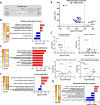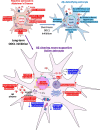Long-term inhibition of ODC1 in APP/PS1 mice rescues amyloid pathology and switches astrocytes from a reactive to active state
- PMID: 38216963
- PMCID: PMC10785549
- DOI: 10.1186/s13041-024-01076-8
Long-term inhibition of ODC1 in APP/PS1 mice rescues amyloid pathology and switches astrocytes from a reactive to active state
Abstract
Alzheimer's disease (AD) is characterized by the loss of memory due to aggregation of misphosphorylated tau and amyloid beta (Aβ) plaques in the brain, elevated release of inhibitory neurotransmitter gamma-aminobutyric acid (GABA) and reactive oxygen species from astrocytes, and subsequent neurodegeneration. Recently, it was found that enzyme Ornithine Decarboxylase 1 (ODC1) acts as a bridge between the astrocytic urea cycle and the putrescine-to-GABA conversion pathway in the brain of AD mouse models as well as human patients. In this study, we show that the long-term knockdown of astrocytic Odc1 in APP/PS1 animals was sufficient to completely clear Aβ plaques in the hippocampus while simultaneously switching the astrocytes from a detrimental reactive state to a regenerative active state, characterized by proBDNF expression. Our experiments also reveal an effect of astrocytic ODC1 inhibition on the expression of genes involved in synapse pruning and organization, histone modification, apoptotic signaling and protein processing. These genes are previously known to be associated with astrocytic activation and together create a neuroregeneration-supportive environment in the brain. By inhibiting ODC1 for a long period of 3 months in AD mice, we demonstrate that the beneficial amyloid-clearing process of astrocytes can be completely segregated from the systemically harmful astrocytic response to insult. Our study reports an almost complete clearance of Aβ plaques by controlling an endogenous degradation process, which also modifies the astrocytic state to create a regeneration-supportive environment in the brain. These findings present the potential of modulating astrocytic clearance of Aβ as a powerful therapeutic strategy against AD.
Keywords: Alzheimer’s disease; Ornithine decarboxylase 1; Reactive astrocytes.
© 2024. The Author(s).
Conflict of interest statement
The authors declare that they have no competing interests.
Figures




Similar articles
-
Astrocytic urea cycle detoxifies Aβ-derived ammonia while impairing memory in Alzheimer's disease.Cell Metab. 2022 Aug 2;34(8):1104-1120.e8. doi: 10.1016/j.cmet.2022.05.011. Epub 2022 Jun 22. Cell Metab. 2022. PMID: 35738259
-
Neuronally Derived Soluble Abeta Evokes Cell-Wide Astrocytic Calcium Dysregulation in Absence of Amyloid Plaques in Vivo.J Neurosci. 2023 Jun 28;43(26):4926-4940. doi: 10.1523/JNEUROSCI.1988-22.2023. Epub 2023 May 26. J Neurosci. 2023. PMID: 37236808 Free PMC article.
-
Astrocytic autophagy plasticity modulates Aβ clearance and cognitive function in Alzheimer's disease.Mol Neurodegener. 2024 Jul 23;19(1):55. doi: 10.1186/s13024-024-00740-w. Mol Neurodegener. 2024. PMID: 39044253 Free PMC article.
-
Effects of CX3CR1 and Fractalkine Chemokines in Amyloid Beta Clearance and p-Tau Accumulation in Alzheimer's Disease (AD) Rodent Models: Is Fractalkine a Systemic Biomarker for AD?Curr Alzheimer Res. 2016;13(4):403-12. doi: 10.2174/1567205013666151116125714. Curr Alzheimer Res. 2016. PMID: 26567742 Review.
-
Astrocyte adaptation in Alzheimer's disease: a focus on astrocytic P2X7R.Essays Biochem. 2023 Mar 3;67(1):119-130. doi: 10.1042/EBC20220079. Essays Biochem. 2023. PMID: 36449279 Free PMC article. Review.
Cited by
-
Diagnostic and therapeutic potential of tonic gamma-aminobutyric acid from reactive astrocytes in brain diseases.Clin Transl Med. 2024 Apr;14(4):e1642. doi: 10.1002/ctm2.1642. Clin Transl Med. 2024. PMID: 38558537 Free PMC article. No abstract available.
-
Integrating Multi-omics Data for Alzheimer's Disease to Explore Its Biomarkers Via the Hypergraph-Regularized Joint Deep Semi-Non-Negative Matrix Factorization Algorithm.J Mol Neurosci. 2024 Apr 15;74(2):43. doi: 10.1007/s12031-024-02211-9. J Mol Neurosci. 2024. PMID: 38619646
-
Aging increases UT-B urea transporter protein abundance in brains of male mice.Physiol Rep. 2025 Feb;13(4):e70175. doi: 10.14814/phy2.70175. Physiol Rep. 2025. PMID: 39967278 Free PMC article.
-
Hydrogen Gas Attenuates Toxic Metabolites and Oxidative Stress-Mediated Signaling to Inhibit Neurodegeneration and Enhance Memory in Alzheimer's Disease Models.Int J Mol Sci. 2025 Jul 18;26(14):6922. doi: 10.3390/ijms26146922. Int J Mol Sci. 2025. PMID: 40725167 Free PMC article.
-
The Role of the Urea Cycle in the Alzheimer's Disease Brain.J Neurochem. 2025 Mar;169(3):e70033. doi: 10.1111/jnc.70033. J Neurochem. 2025. PMID: 40022483 Free PMC article. Review.
References
-
- Pegg AE. Polyamine metabolism and its importance in neoplastic growth and as a target for chemotherapy. Can Res. 1988;48(4):759–774. - PubMed
MeSH terms
Substances
Grants and funding
LinkOut - more resources
Full Text Sources
Medical
Molecular Biology Databases
Research Materials

